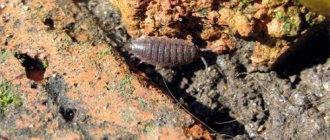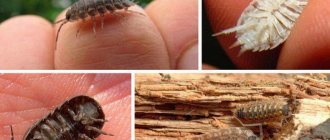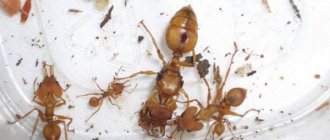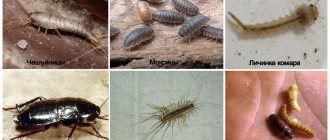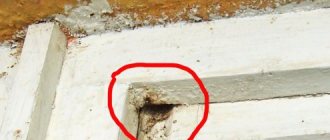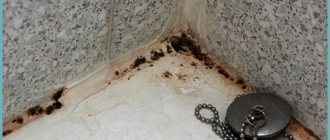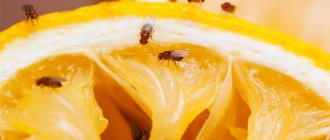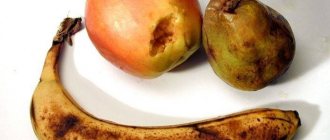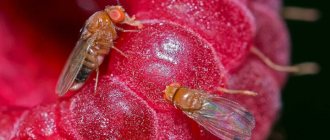What insects can live in the bathroom? There aren't that many varieties. This is explained by the fact that there is increased humidity in the room. And not all insect representatives will like such conditions. So, in the bathroom they start:
- silverfish having an elongated body of a light gray color, with three hairs at the end;
- butterflies - small black midges with wings 2-3 mm long;
- mosquitoes are well-known blood-sucking insects;
- cockroaches.
Mosquitoes love a humid atmosphere, which is why they often fly to the bathroom. Cockroaches crawl into the room through the ventilation.
Representatives such as woodlice, centipedes, flycatchers, and nooses may also appear in the bathroom. All of them are not insects, although few people know about this. Nevertheless, it is also necessary to fight them.
How to deal with white insects in the bathroom yourself?
To independently combat insects, you can use household chemicals, which are relatively low cost but quite effective.
Among them are the following:
- copper sulfate;
- cleaning products for plumbing equipment that contain chlorine;
- boric acid powder. It is necessary to prepare a disinfectant solution at the rate of 1 part powder to 4 parts water and treat the bathroom with the resulting mixture. After about a week, it is necessary to carry out general cleaning in order to remove any remaining powder and dead insects. After some time, the treatment should be repeated. This will help get rid of young silverfish that have just hatched from their eggs.
An effective remedy in the fight against insects is the drug Butox 50
. The product is diluted with water and the resulting solution is used to treat the bathroom.
Mechanical methods of controlling insects in the bathroom
- a trap made of wet newspaper
(the cheapest and easiest way), which must be spread on the bathroom floor and left overnight. Since silverfish are partial to damp places, they occupy the trap in the morning. All you have to do is roll up the newspaper, take it out of the room and burn it; - trap from a jar
, which must be wrapped with tape or newspaper, and a piece of bread or apple placed inside. Leave the device overnight.
How to get rid of insects using folk remedies?
You can remove small insects using folk remedies, which include citrus fruits, naphthalene, spices, cedar or naphthalene.
Professional extermination
Most often, professional exterminators use a preparation such as liquid cypermethrin.
. Aqueous emulsion is used to treat cracks and cracks around doorways, as well as baseboards. In this way, only adult insects are destroyed; this drug has no effect on laid insect eggs.
Attention, TODAY only!
If you find silver insects crawling in your bathroom, but don’t know what to do or how to get rid of them, below we will tell you about insects in the bathroom and toilet.
Before answering the question of what kind of very small transparent insects are crawling in the bathroom, shown in the photo below, it is worth figuring out where the white insects in the bathroom and toilet could have come from and what they are called. After all, you probably keep the bathroom clean and promptly remove rust and mold.
Insects can appear in the bathroom and toilet for several reasons:
- increased air humidity;
- wet floor in the room after taking a shower;
- failure to treat the toilet with disinfectants;
- accommodation on the ground floor;
- poor condition of sewer pipes.
In fact, insects living in the bathroom and toilet are quite unpretentious; they can appear simply from high humidity. Below we provide photos of strange insects that may appear in the bathroom.
Recognizing their appearance is quite simple: you will see them almost immediately. Below you can see photos of insects in the bathroom with names. Almost all the inhabitants of bathrooms come out of their nests only when it is dark, so as soon as you turn on the light, you will immediately see small, small insects scattering in the bathroom.
Woodlice
Wood lice often appear in the bathroom and toilet. They are mistakenly called insects, although they belong to the class of crustaceans. It’s just that the relatives of crayfish have adapted to life on land, although they look for places with high humidity. They are easy to distinguish by their appearance - they have an oval body, convex at the top, divided into segments and covered with hard plates. The body may be light, with a slight yellowish tint, or dark brown or gray. Another distinctive feature is their behavior: in case of danger, woodlice curl up into a ball.
These insects are frequent guests in the bathroom. They are called wood lice
Woodlice feed on rotting organic matter. Spoiled vegetables, fruits, herbs are from the diet. Fungi that develop in damp areas are also suitable for them to feed on. Therefore, in addition to the bath and toilet, they can be found in the kitchen, and brought in with spoiled food. It also finds them in rooms if apartment dwellers or pets have a habit of leaving food under beds or sofas.
You can get rid of wood lice in the bathroom and toilet only by thoroughly drying the room, removing all possible sources of food. In addition to the measures described above (prevent water from getting on the floor, walls, improve ventilation), it is necessary to carry out thorough cleaning and disinfection. You can use a solution of bleach, Domestos, and other similar products for these purposes.
Are they dangerous for humans?
Almost all of these species, with the exception of silverfish, are quite dangerous. These insects themselves cannot cause harm, but they are carriers of a large number of quite dangerous diseases:
- viral infections;
- pathogenic bacteria;
- fungi;
- Ascaris eggs.
If you do not maintain the hygiene of your room well, then your risk of infection is quite high.
How to get rid of these pests
What to do if small long insects are running around in the bathtub? There are many ways to get rid of insects in the bathroom. People use both homemade recipes for removing unpleasant neighbors and radical chemical insecticides.
Quite often used among housewives:
- aerosols are a universal means of combating almost all types of pests living in your home. The aerosol provides convenient packaging, a special nozzle for treating hard-to-reach places, affects most pests, and also has a fairly low price compared to other insect repellents. In addition, modern aerosols have virtually no unpleasant odor or use fragrances, which is one of the biggest advantages when choosing an insecticide;
- Fumigators are also an effective remedy for pests; they have a high price, but are characterized by a complete absence of odor. The only disadvantage of the fumigator is that turning on electrical appliances in the bathroom at high humidity is a rather dangerous undertaking, so before using the fumigator, make sure that the air humidity in the room meets the required standards;
- Insect traps are a cardboard structure, inside treated with strong glue containing pheromones from females of a certain type of pest. Males react to pheromones and crawl towards the trap, where they freeze in glue. The method is effective, but it will take more time than if you used an aerosol;
- gels and crayons against crawling insects. They contain a strong insecticide poison and bait. The substance is distributed in the corners, as well as the baseboards of the room. The victim reacts to the smell of the bait and falls into the substance. The poison gets on the pest’s paws, dissolves the shell and penetrates the body. The insect carries the poison to its colony, where it infects other relatives. As a result, the entire family dies within a few days.
Ready-made remedies for the fight
If you don't know how to get rid of white bugs in the bathroom, here are three of the most popular chemical insecticides:
- Aerosol Raptor.
- Aerosol “Clean House”.
- Gel Fas.
The best remedy for pest control not only in the bathroom, but also in the entire apartment. The aerosol contains a powerful insecticide, which by spraying gets into all hard-to-reach places. The product has a pleasant mint flavor, which allows it to be used in enclosed spaces without the need for subsequent ventilation. In addition, Raptor aerosol has a fairly low price compared to other insecticidal products, which makes it affordable for normal use.
Analogous to Raptor aerosol, but from a different manufacturer. Contains the same insecticide, but mixed with other flavorings. The price is slightly lower than the Raptor, which is why we are very fond of middle-aged housewives.
A very good assistant in the fight against all crawling insects. It has original packaging that allows you to conveniently use the gel. One package is enough to treat an average one-room apartment, and the price will pleasantly surprise you. It has no pungent odor and does not cause any discomfort when used. Safe for pets.
Folk remedies
Our ancestors struggled with insects for a long time before the advent of insecticides and came up with a lot of folk remedies for controlling bathroom pests. We will tell you about the three most effective methods.
1. The best way to kill any bathroom insects is boric acid. It is completely safe for humans, but it brings almost instant death to all unpleasant neighbors. To remove unwanted guests you will need:
- a teaspoon of boric acid;
- glass of water;
- a teaspoon of sugar, honey or jam.
You will need to do the following:
- Mix water, boric acid, sugar.
- Treat all surfaces, floors and walls of the bathroom with the resulting mixture.
Boric acid gives almost instant results, corroding insects from the inside.
2. Another effective remedy is vinegar.
You will need:
- a teaspoon of table vinegar;
- liter of water.
To treat a bathroom with this solution, follow the following algorithm:
- Mix vinegar with water.
- Wear special protective gloves to avoid burns.
- Treat all surfaces in the room with the resulting mixture.
3. Another good remedy for dealing with unwanted neighbors is a solution of baking soda, which is a strong poison for most insects.
You will need:
- packaging of baking soda;
- a bucket of water.
The recipe is quite simple:
- Mix baking soda and water.
- Wear special protective gloves.
- Treat all accessible surfaces with the solution.
Where to buy
We will tell you where you can buy ready-made products to combat insects in the bathroom and toilet. This can be done at the following addresses in your city:
| Name of shop | Address | Product name | Price, rub |
| Moskhoztorg | Moscow, New Arbat, 6 | Aerosol Raptor | 110 |
| Burgher | St. Petersburg, st. Shipbuilders, 34 | Gel Fas | 79 |
| Atlanta | Ufa, st. Novozhenova, 88 | Aerosol “Clean House” | 70 |
| lily | Norilsk, st. Shkolnaya, 7 | Gel Fas | 85 |
| Cosmo-M | Belarus, Minsk, Nezavisimosti Ave., 11 | Aerosol Raptor | 9.5 bel. rub. |
| Domestic | Ukraine, Kyiv, st. Molodogvardeyskaya, 20 | Aerosol “Clean House” | 28 UAH |
Agree, it’s an unpleasant situation: you went into the bathroom, turned on the light, and unpleasant-looking insects began to scatter from under your feet, hiding in safe places. Most likely these are silverfish that crawl out to hunt at night. Are you wondering where they came from? But, in principle, it is not so important how they got into the apartment. The main thing is to know how to get rid of them. Silverfish do not harm humans, but they are not worth breeding either.
Types of silverfish: what “enemy” you have to deal with
Silverfish in an apartment is the result of unsanitary conditions
Appearance of “lovers” of humid climates
The insect's body length can reach 1.9 cm, it is flat, tapering from head to tail. The silverfish got its name from the silvery scales with which it is covered. From the head, two whiskers are directed forward, three similar tails are directed behind, there are no wings. The eyes are compounded, with color vision that perceives ultraviolet light.
The common silverfish, or as it is also called, the sugar fish, moves very quickly along the floor, ceiling, can run into a narrow crack, hide in a hole, and all this with the help of three pairs of legs with tenacious claws. Such organs of movement make it difficult to fight insects, since seeing does not mean catching, and they hide perfectly.
If you look closely, you can catch the resemblance to a fish fry, for which the British call it silverfish. Scientists have counted almost 600 species of silverfish in nature, 10 of which live in Russia. But only two apartments are besieged by silverfish and house thermobia.
Places of deployment and diet
Knowing the “habits” of insects makes it easier to find and destroy them. Most of all, they like to hide in damp places, where they can profit from something. They eat quite a varied diet. Paper, wallpaper, books, bulk products (flour, pasta, cereals), animal feed, cotton and silk items are used. The most unpleasant thing is that the lack of food does not frighten them; in favorable living conditions, they can live for about a year without food at all, and with good nutrition they can live for five years.
Determining whether there is a silverfish in an apartment or not is sometimes difficult, since the insect prefers a nocturnal lifestyle. First of all, where it can be found - places with humid air, condensation, water. These are bathrooms, toilets, shower boxes, and other places that are often closed during renovation, creating an aesthetic appearance - sewer pipes and cold water pipes located in hard-to-reach places, for example, under the bathtub.
Important! Silverfish insects that come into your home are not carriers of diseases, they do not bite, but you must fight them!
What small insects are most often found in flower pots?
Parasites can settle not only on the green parts of plants (leaves, stems), but also in the soil of flowerpots and flower pots, damaging the root system of flowers. Neither ornamental plants (palm trees, dracaenas, ficus, violets) nor seedlings that are grown at home before being planted in open ground are protected from damage by them. Most often, the following settle in the substrate in which home flowers and seedlings grow:
- felt bugs (mealybugs);
- root scale insects;
- fools;
- larvae of sciarids (detritus, soil or leaf mosquitoes).
Small species of insects that live in flower pots have different food supplies. Some of them eat exclusively ornamental crops, others are universal pests.
We suggest you read: Warm milk for constipation
How to deal with silverfish
Prevention
It is very important to observe basic rules of room hygiene, and to begin fighting as soon as single individuals are discovered.
- Silverfish will not settle in the bathroom if the room is constantly ventilated and ventilated, and any puddles that form on the floor are wiped off immediately.
- Old pipes become covered with condensation, and with poor ventilation, puddles form - an excellent place for insects to gather.
- Get rid of old papers and waste paper.
Advice. Library owners! From time to time, thoroughly ventilate the room and monitor its microclimate, avoiding an increase in humidity.
- Caulk any cracks where insects may gather.
- If mold appears, remove it immediately.
- Store bulk food products in hermetically sealed jars, boxes, and containers.
Where does the attack come from?
There are basically two objective reasons for the appearance of “tenants”:
- various types of communications - woodlice, millipedes, etc. migrate with impunity through ventilation shafts;
- interruptions in the operation of filtration systems, for example, in the tap water there may be small black worms in the bathroom - mosquito larvae.
We create the remaining prerequisites ourselves in pursuit of glamorous design or due to banal laziness, they can be:
- warm water pipes hidden in boxes under the casing; but small-timers will always find a micro-crack to squeeze through to visit you;
- condensation flowing into nooks and crannies under the bathtub that are difficult to reach;
Pandemonium in a wet corner
- damp rugs on the floor near the bathroom/toilet;
- dust;
- clogged drains;
- storage area for rags under the bathroom.
Folk remedies
Traps
Preventative measures did not help scare away insects from your home, but they still made their way in? Let's look at how to remove silverfish using traditional methods.
Common and accessible traps are:
- Wrap the outside of a liter jar with adhesive tape and put a few pieces of bread inside. The insect will easily get into the jar, but will not be able to get out along the slippery walls. Set the trap overnight in the place where silverfish are spotted.
- Twist (crumple) a newspaper or other paper, moisten it with water (lightly so as not to get wet) and leave it overnight. Insects will immediately settle there, as they love moisture and darkness. In the morning, take the paper outside, away from the house and burn it.
- Traps that can be purchased in stores are effective. These are Velcro, which are thin cardboard with an adhesive surface. They do not give a second chance to stuck insects. Trapper Insect Trap and Trapper Max Glue Traps are laid out in places where silverfish accumulate and the “fillability” is periodically checked.
Homemade herbs and compounds
A clean, dry bath is an unpleasant environment for silverfish.
Spices
In addition to traps, other methods of combating silverfish are used. Insects cannot tolerate strong odors, such as bay leaves, cinnamon or pepper. They do not live in rooms with such odors.
Soap based balls
Once a silverfish has taken up residence in the toilet, it will quickly leave it; wash the toilet with this product. For 1 cup of baking soda – 2 tablespoons of grated laundry soap (72%), ¾ cup of hydrogen peroxide and 10 drops of lavender or citrus oil. Make small balls from this mixture and wash the toilet, spreading it over the inner surface twice a week. Thanks to this aromatic product, the toilet will have a pleasant smell, and insects will run away.
Oils
Lavender and citrus oils can be used in other ways. Add a few drops to water and wash or spray the resulting solution in areas where silverfish accumulate. As the aromas of the oil fade, repeat the procedure.
In addition to oily mixtures of lavender and citrus fruits, they are used in their natural form. After grating the zest of a lemon or orange, scatter it in places where the insect is likely to live. Lavender branches will also repel the pest.
Freezing
Not only the adult individual is afraid of low temperatures; the silverfish larva also dies in the cold. Therefore, if in winter it is possible to “freeze” the room, do this procedure.
What chemicals are more effective against silverfish?
Today on the insecticide market there are a large number of drugs to combat silverfish. They are presented in different forms, but it is better to use them in combination, as recommended by sanitary doctors.
- The bulk Demon Wp product containing cypermethrin is effective against many insects, including silverfish.
- Quite conflicting reviews about Safer Brand powder. The active substance is kieselguhr (dialomite). The way it affects insects is that the powder, made from rock, has sharp edges of grains of sand. When they enter an insect's body, they literally “cut” it from the inside. The product is safe for people and pets, but direct contact should still be avoided. In the evening, sprinkle powder along baseboards or other habitats, and carefully remove in the morning (along with dead insects).
- Boric acid is effective against silverfish, but is dangerous for people and animals, so when using it, safety precautions must be observed.
- An aerosol against silverfish with the active substance – pyrethrin, is a ready-made poison against insects. It must be used carefully, avoiding places where food products are located, children and pets. Spray on baseboards, in cracks, on water and sewer pipes and other places where insects accumulate.
To avoid having to fight silverfish, it is better to prevent the appearance of insects in the apartment. An elementary preventative “remedy” - cleanliness in the room, will help its inhabitants not to “share” their home with the pest.
Even the cleanest and most well-groomed apartment is not a guarantee that white insects will not settle in it - in the bathroom, in the toilet, in the kitchen - after which any person has a natural desire to get rid of them. Small creatures feel great where there is free access to water and food.
Types of insects
The most common types are usually familiar to most people.
- Silverfish are small insects, the body (its length is up to one centimeter) is elongated, light gray or white, almost transparent, with three hairs at the end. They are active at night, move very quickly, feed on organic matter - leftover food, mold, wet paper, synthetic fiber, dead brothers. They multiply slowly, so it’s not difficult to fight them - just treat the room with a high-quality household aerosol.
- Woodlice have a gray, brown or white body, divided into segments - with a pair of legs on each. They absolutely cannot do without water, since they are land crustaceans and breathe exclusively with the help of gills. They feed on plant debris, reproduce very quickly - each female lays up to a hundred eggs (the average clutch is 70 eggs) and after 25 days an individual appears, almost in no way inferior to adults, but becomes full-fledged only after a few molts.
- Ordinary mosquitoes live, breed and like to rest during the day in rooms with high humidity. The bathroom is just such a place.
- Cockroaches, midges, spiders, ants, centipedes penetrate through ventilation ducts from neighboring apartments or the basement.
The microclimate of the bathroom promotes the proliferation of various insects; most often, silverfish, which are harmless to humans (they are not carriers of diseases), or more dangerous wood lice, whose legs can cause irritation, are found.
The most suitable habitats:
- water and sewer pipes accumulating condensation on the surface;
- hard-to-reach areas of the bathroom - hidden communications, corners;
- wet hygiene products, always wet floor mats of poor quality;
- Places where dust is rarely cleaned are shelves, cabinets, and the floor under the bathroom.
Silent occupation
A bathroom is a specific room with a high level of humidity, located in the dark most of the day. Such conditions are ideal for small crawling and running animals, for which everyone often creates favorable conditions with their own hands.
Dragons will soon live here
If you Google it, you will be surprised to learn that crustaceans and even animals may also be scurrying around under your feet! Let's look at the most typical bathroom troublemakers:
- silverfish are primarily wingless insects from the bristletail order;
- woodlice - a class of higher crayfish of the order of isopods;
- nods - invertebrates from the order Centipedes;
- centipedes are arthropods considered to be the closest relatives of insects;
- mosquitoes are insects from the order Diptera;
- Tubifex - class zonalis, subclass oligochaetes.
Silverfish
Small white worms in the bathroom, at first glance, turn out to be elegant insects up close - sugar silverfish up to 2 cm long, with a characteristic teardrop-shaped body and three tail processes. Not being predators by nature, they can cause significant damage to wallpaper, linen, and books (think about it, fans of newspaper racks in the bathroom).
It also feeds on mold and fungi that grow only in a humid environment, so the appearance of sugar silverfish should alert you . The insect does not hibernate, but diligently reproduces, laying about 70 eggs in June-July.
The habit of hiding in the natural environment under stones, sticks, and in the leaves of a sugar bowl is also retained in the bathroom, cleverly being buried:
- in crevices;
- under peeling paint;
- under the bathtub, basins;
- in caked underwear.
Preferring darkness, silverfish rush in different directions as soon as a bright light comes on. However, on glazed tiles their speed decreases sharply, and if they get into a puddle or even a drop of water, they stop altogether.
Kivsyaki
Living in natural conditions, mostly underground, it appears by chance in the fallen leaves in the bathroom. Thanks to their smooth body, they look like worms in the bathroom, although specimens up to several centimeters in length make them look like snakes.
Demo version of kivsyak
The body of the centipede is covered with a chitinous layer, which does not prevent it from curling up smartly in case of danger. The “worms” move quite slowly, you can simply pick them up with your hand and take them outside, especially since they process plant residues well.
Woodlice and mosquitoes
These creatures, as a rule, appear by chance - woodlice, usually rise from the basement or ventilation ducts and quickly leave if the humidity is low. If these crustaceans stubbornly refuse to leave, most likely a pipe is leaking somewhere, creating favorable conditions for their residence.
Woodlice look like miniature armadillos - they curl up into a tight ball when touched; they are gray on top (juveniles are light-colored) and have a whitish belly. May cause harm:
- indoor plants;
- to humans, because they are carriers of fungal pathogens, depriving.
Mosquitoes fly into the bathroom, mainly if there is stagnant water in some container or there is no mosquito protection on the windows. They cannot reproduce here because the larvae must develop in stagnant water.
flycatcher
What is capable of inspiring horror is this fast-moving (40 cm/sec), silent arthropod, appearing out of nowhere and smoothly “flowing around” obstacles. The abundance of long legs and the longest mustaches are frightening, which can be confused with the same long hind legs - just pull and push.
Effective methods of control
Typically, insects are nocturnal; they live in the seams between tiles, plumbing joints, behind the washing machine, and even in the laundry basket. They have an unpleasant appearance - an elongated body, many legs, antennae. From drying out, small creatures are reliably protected by a dense horny growth - scales or a miniature shell, so they are sometimes found in dry places. It is difficult to determine the location of the population, since they appear only at night, and when the lights are turned on, they scatter in panic in all directions.
To get rid of insects forever, you need to take a whole range of measures.
- Arrangement of high-quality ventilation.
- Regular ventilation of the bathroom.
- Thorough dust removal even in the most inconvenient areas.
- Drying damp corners using electrical appliances.
- Periodic sanitization of the premises with a substance containing chlorine.
- Storing all available products in closed containers.
If there are insects, first of all you need to try to get rid of them using drugs and folk remedies that are safe for health, but if they become widespread, the area will need to be treated with aggressive substances.
A timely response to the appearance of the first individual will allow you to quickly and effectively localize further spread. This is easy to do with the help of modern insecticides.
After these procedures, insects will find themselves in an environment unsuitable for their life. When cleaning, it is recommended to use products that do not have a negative effect on humans - soda ash or baking soda, laundry soap, lemon. For prevention, a mixture of boric acid and chalk can be poured under the furniture in a ratio of 1:4. To enhance the effect, you should lay out bunches of medicinal plants that repel uninvited guests with their smell. Wormwood, tansy, rosemary, lavender or cloves of unpeeled garlic are suitable.
Why do they appear?
Insects breed at temperatures not lower than twenty degrees, so regular ventilation of the bathroom during the cold season will get rid of not only adult insects, but also future offspring in the clutches. However, the most effective method of control remains the use of a variety of chemicals, which today can be freely purchased at retail outlets. Their use will give hope that insects will never appear in the house again, disrupting the usual way of human life.
Measures to prevent the appearance of food moths
Fighting the larvae of an adult butterfly and the adults is one thing. But even if the problem is not relevant yet, it would not hurt to think about using preventive measures. Simple actions will become reliable protection for the room and the answers to the question of what to do if white worms are crawling on the ceiling in the kitchen will lose their relevance.
In order to protect the ceiling finish, and at the same time food supplies, it is necessary to follow simple rules for storing groceries, using sealed glass jars, which must be disinfected if kitchen pests have previously settled in them.
An easy way to keep moths out is to not stock up too much. The smaller the grains, the shorter their shelf life will become, and therefore the risk of infection.
Regular cleaning of kitchen cabinets with the accompanying use of dry herbs to repel them is another simple and affordable preventive method of combating not only food moths, but also other types of domestic pests.

